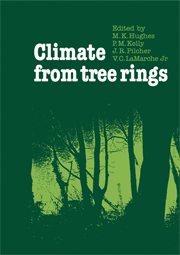3 - THE SOUTHERN HEMISPHERE
Published online by Cambridge University Press: 05 October 2010
Summary
INTRODUCTION
The Editors
In Chapters 3 and 4, the current extent of the dendroclimatological data base is reviewed and the prospects for expansion in space and time are assessed. The geographical areas referred to in these two chapters reflect areas of research activity rather than climatically or dendrochronologically distinct regions. The climatologists present at the Second International Workshop on Global Dendroclimatology played an active part in the discussions and research priorities were assessed on both climatological and dendrochronological grounds. This was the first time that the potential users of dendroclimatic data had been directly involved at this early stage of the reconstruction process and it proved of great value. Knowledge of the characteristics of the spatial patterns of climatic variation evident in instrumental records was used to guide sampling strategies, alongside the more commonly used principles of dendrochronology.
Salinger describes the climatology of the Southern Hemisphere. The small land area in the temperate zone and its generally low relief, as well as the presence of the ice-covered continent of Antarctica, promote a vigorous year-round circulation. The strong but eccentric circumpolar vortex of low surface pressure is one manifestation of this. The associated extratropical depressions provide the seasonal or year-round rainfall that supports the forest and woodland vegetation of the southern parts of the continents and New Zealand. This rainfall is modified by rain-shadow effects in eastern New Zealand and Argentina and in interior South Africa and Australia.
- Type
- Chapter
- Information
- Climate from Tree Rings , pp. 78 - 104Publisher: Cambridge University PressPrint publication year: 1982



